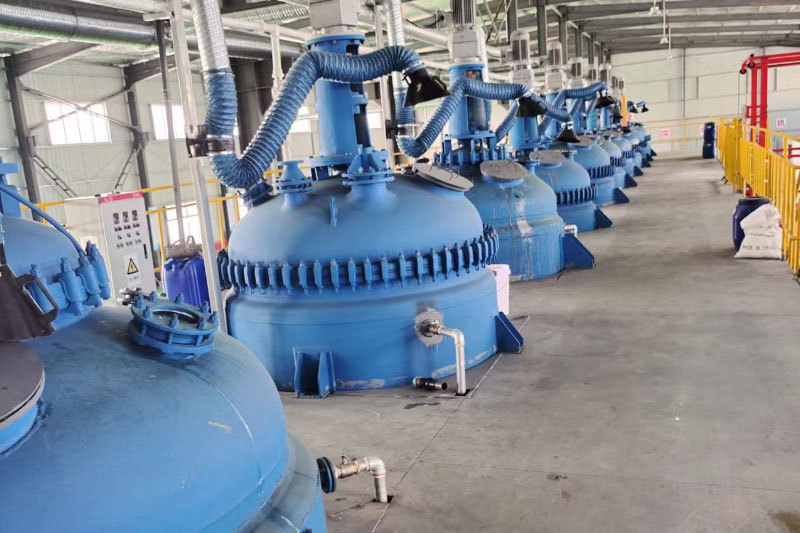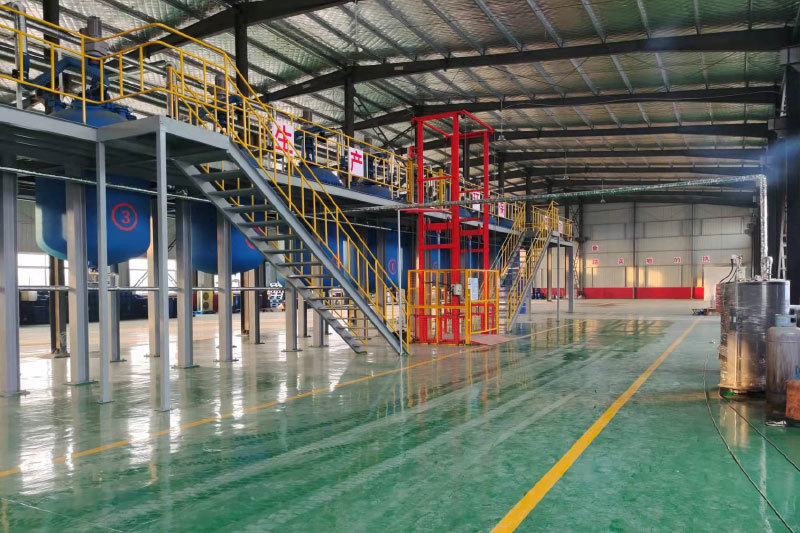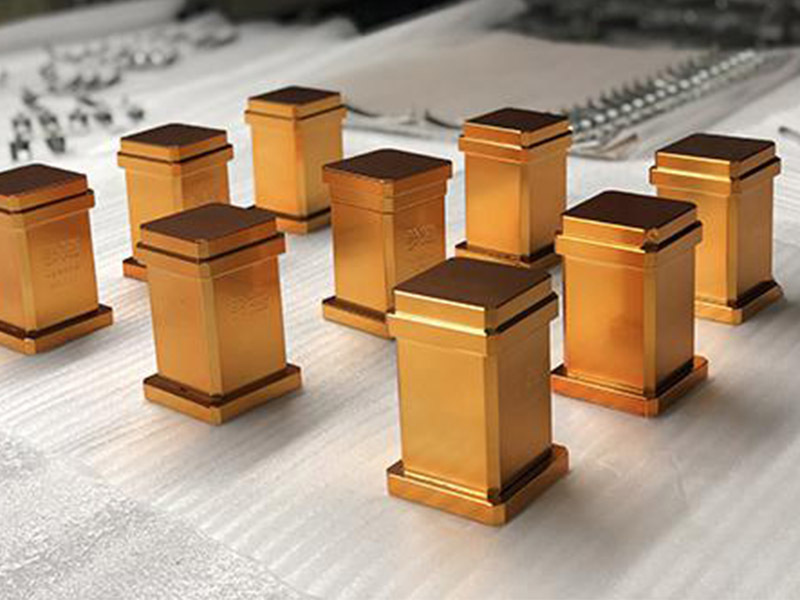News Details
31
2023
-
10
Galvanizing refers to the surface treatment technology of plating a layer of zinc on the surface of metal, alloy or other materials to play a role in beauty, rust prevention and so on.
Galvanizing refers to the surface treatment technology of plating a layer of zinc on the surface of metal, alloy or other materials to play a role in beauty, rust prevention and so on. The main method used is hot galvanizing
Zinc is soluble in acid, but also soluble in alkali, so it is called amphoteric metal. Zinc hardly changes in dry air. In humid air, a dense basic zinc carbonate film is formed on the surface of zinc. In the atmosphere containing sulfur dioxide, hydrogen sulfide and marine, the corrosion resistance of zinc is poor, especially in the atmosphere of high temperature and high humidity containing organic acid, zinc coating is easy to be corroded. The standard electrode potential of zinc is -0.76V. For steel substrates, zinc coating belongs to anodic coating, which is mainly used to prevent corrosion of steel, and its protective performance is closely related to the thickness of the coating. After the zinc coating is passivated, dyed or coated with light protection agent, its protective and decorative properties can be significantly improved.
With the development of galvanizing technology and the adoption of high-performance galvanizing brighteners, galvanizing has entered protective-decorative applications from simple protective purposes [1]. There are two types of zinc plating solutions: cyanide plating solution and cyanide-free plating solution. Cyanide plating solution is divided into micro cyanide, low cyanide, medium cyanide, and high cyanide. Cyanide-free plating solutions include alkaline zincate plating solution, ammonium salt plating solution, sulfate plating solution and ammonia-free chloride plating solution. The cyanide zinc plating solution has good plating ability, and the obtained coating is smooth and meticulous, which has been used for a long time in production. However, due to the high toxicity of cyanide and serious environmental pollution, low cyanide, micro-cyanide and non-cyanide zinc plating solutions have been used in recent years. In the plating tank containing galvanizing solution, the cleaned and specially pretreated parts to be plated are used as cathodes, and the plated metal is used as anodes, and the two poles are respectively connected with the positive and negative poles of the DC power supply. The galvanizing bath is composed of an aqueous solution containing a compound of a plating metal, a conductive salt, a buffer, a pH adjuster, an additive, and the like. After electrification, the metal ions in the zinc plating solution move to the cathode under the action of the potential difference to form a coating. The metal of the anode forms metal ions into the zinc plating bath to maintain the concentration of the metal ions being plated. In some cases, such as chromium plating, an insoluble anode made of lead and lead-antimony alloy is used, which only serves to transfer electrons and conduct current. The concentration of chromium ions in the electrolyte is maintained by periodically adding chromium compounds to the bath. When galvanizing, the quality of the anode material, the composition of the galvanizing solution, temperature, current density, power-on time, stirring intensity, precipitated impurities, power supply waveform, etc. will affect the quality of the coating and need to be controlled in a timely manner. Category broadcast editor Cold galvanizing Cold galvanizing is also called electro-galvanizing. It uses electrolytic equipment to deoil, pickling, and then put the pipe into a solution composed of zinc salt, and connects the negative electrode of the electrolytic equipment. A zinc plate is placed on the opposite side of the pipe, and the positive electrode connected to the electrolytic equipment is connected to the power supply. The directional movement of current from the positive electrode to the negative electrode will deposit a layer of zinc on the pipe. 1, the principle of zinc in dry air is not easy to change, and in humid air, the surface can generate a very dense zinc carbonate film, this film can effectively protect the internal no longer subject to corrosion. And when the coating is damaged for some reason and the substrate is not too large, the zinc and steel substrate form a micro battery, so that the fastener substrate becomes the cathode and is protected. It is widely used in automobile transportation and other industries, but what is needed is a trivalent chromium passivation layer and a zinc-nickel alloy plating sealing coating to reduce the harmful and toxic layer of hexavalent chromium passivation. 2. Performance characteristics: The zinc coating is thick, crystalline, uniform and pore-free, and has good corrosion resistance. The zinc layer obtained by electroplating is relatively pure and corrodes slowly in fog such as acid and alkali, which can effectively protect the fastener substrate. The galvanized layer is passivated by chromic acid to form white, color, Army Green, etc. It is beautiful and elegant, and has certain decoration. Because the galvanized layer has good ductility, therefore, cold punching, rolling, bending and other forming can be carried out without damaging the coating. 3. The scope of application of electro-galvanizing involves more and more extensive fields. The application of fastener products has spread to machinery manufacturing, making galvanized hook mesh, electronics, precision instruments, chemical industry, transportation, aerospace, etc., which are of great significance in the national economy. Mechanical galvanizing is carried out in a rotating drum equipped with plated parts, glass balls, zinc powder, water and accelerant. The glass balls as impact medium rotate with the drum, friction with the surface of the plated parts and hammering to generate mechanical physical energy. Under the action of chemical accelerant, the plated zinc powder is "cold welded" to the surface of the plated parts to form a smooth, uniform and detailed coating with a certain thickness. The technical standard adopts ASTM B695-2000 and military C- 81562 mechanical galvanizing technical standard. The main method of surface galvanizing of hot-dip galvanized steel sheet is hot-dip galvanizing. Hot-dip galvanizing is developed from the older hot-dip plating method. Since 1836, France has applied hot-dip galvanizing to industry, which has a history of 170 years. However, the hot-dip galvanizing industry has been developed on a large scale with the rapid development of cold-rolled strip steel in the past 30 years. The production process of hot-dip galvanized sheet mainly includes: original sheet preparation → pre-plating treatment → hot-dip plating → post-plating treatment → finished product inspection, etc. According to the habit often according to the different pre-plating treatment methods, the hot-dip galvanizing process is divided into two categories: out-of-line annealing and in-line annealing, that is, wet (single sheet hot galvanizing method), out-of-line annealing (single sheet hot galvanizing method), hot galvanizing Huilin (Wheeling) method (strip steel continuous hot galvanizing method), in-line annealing Sendzimir (Sendzimir) method (shielding gas method), modified Sendzimir method, American steel joint method (same as Japanese Kawasaki method), Silas (Selas) method and Sharon (Sharon) method. Out-of-line annealing means that before hot-rolled or cold-rolled steel plates enter the hot-dip galvanizing line, recrystallization annealing is first carried out in a bottom-pumping annealing furnace or a hood annealing furnace, so that there is no annealing process in the galvanizing line. Before hot-dip galvanizing, the steel plate must maintain a clean, pure iron active surface free of oxides and other dirt. This method is to remove the annealed surface oxide scale by pickling, and then apply a layer of zinc chloride or a mixture of ammonium chloride and zinc chloride to protect the steel plate from being oxidized again. (1) The solvent on the surface of wet hot-dip galvanized steel sheet is not dried (that is, the surface is still wet) and enters the zinc liquid covered with molten solvent on the surface for hot-dip galvanizing. The disadvantages of this method are: a. It can only be galvanized in a lead-free state, and the alloy layer of the coating is very thick and the adhesion is very bad. B. the generated zinc slag is accumulated at the interface between zinc liquid and lead liquid and cannot be deposited at the bottom of the pot (because the specific gravity of zinc slag is greater than that of zinc liquid and less than that of lead liquid), thus the steel plate pollutes the surface due to passing through the zinc layer. Therefore, this method has been basically eliminated. (2) single sheet steel plate this method is generally the use of hot rolled plate as raw material, first of all after the annealing of the steel plate into the pickling workshop, with sulfuric acid or hydrochloric acid to remove the iron oxide scale on the surface of the steel plate. After pickling, the steel plate immediately enters the water tank to soak and wait for galvanization, which can prevent the steel plate from being oxidized again. After pickling, water cleaning, squeezing, drying, hot galvanizing in a zinc pot (the temperature is kept at 445-465 ℃), then oiling and chromating. The quality of hot-dip galvanized sheet produced by this method is significantly improved than that of the finished product of wet galvanizing, and it is only valuable for small-scale production. (3) Huilin Method Hot The continuous galvanizing production line includes a series of pretreatment processes such as lye degreasing, hydrochloric acid pickling, water washing, solvent coating, drying, etc., and a bell furnace is required before the original plate enters the galvanizing line for galvanizing. The production process of this annealing method is complex, the production cost is high, and more importantly, the products produced by this method often have solvent defects, which affect the corrosion resistance of the coating. In addition, AL in the zinc pot often reacts with the solvent on the surface of the steel plate to generate aluminum trichloride and consume it, thus deteriorating the adhesion of the coating. Therefore, although this method has been published for nearly 30 years, it has not been developed in the hot-dip galvanizing industry in the world. In-line annealing is to provide a coil directly from the cold-rolled or hot-rolled workshop as the original plate for hot-dip galvanizing, and to perform gas-protected recrystallization annealing in the hot-dip galvanizing line. Hot dip galvanizing methods belonging to this industry include: Sendzimir method, modified Sendzimir method, American steel joint method (same as Kawasaki method in Japan); Silas method; Sharon method. (1) Sendzimir method strip steel continuous hot galvanizing production process flow chart It is the annealing process and hot galvanizing process combined, the line annealing mainly includes oxidation furnace, reduction furnace two parts. The strip steel is directly heated to about 450 degrees by the gas flame in the oxidation furnace to burn the residual rolling oil on the surface of the strip steel and purify the surface. After that, the strip steel is heated to 700-800 degrees to complete recrystallization annealing. The temperature before entering the zinc pot is controlled at about 480 degrees through the cooling section. Finally, it enters the zinc pot for galvanizing without contacting air. Therefore, Sendzimir method has high output and good galvanizing quality. This method has been widely used. (2) The U.S. Steel Joint Method is a variant of the Sendzimir method. It only uses an alkaline electrolytic degreasing tank to replace the degreasing effect of the oxidation furnace. The rest of the process is basically the same as the Sendzimir method. After the original plate enters the production line, electrolytic degreasing is first carried out, then water washing and drying are carried out, recrystallization annealing is carried out through a reduction furnace with protective gas, and finally hot galvanizing is carried out in a zinc pot under sealed conditions. In this method, because the strip is not heated by the oxidation furnace, the oxide film on the surface is thin, and the hydrogen content of the protective gas in the reduction furnace can be appropriately reduced. This is advantageous for furnace safety and reduced production costs. However, since the strip enters the reduction furnace without preheating, this undoubtedly increases the thermal load of the reduction furnace and affects the life of the furnace. Therefore, this method is not widely used. (3) Silas method is also called direct flame heating method; First, the strip steel is degreased by alkali washing, then the oxide scale on the surface is removed with hydrochloric acid, and after washing and drying, it enters a vertical in-line annealing furnace directly heated by gas flame. By strictly controlling the flame burning ratio of gas and air in the furnace, incomplete flame burning is carried out under the condition of excess gas and insufficient oxygen, thus creating a reducing atmosphere in the furnace. The strip is rapidly heated to the recrystallization temperature and cooled in a low hydrogen protective atmosphere, and finally immersed in a closed zinc liquid for hot-dip galvanizing. This method has compact equipment, low investment cost and high output (up to 50/hour). However, the production process is complex, especially when the unit stops running, in order to avoid burning the strip steel, it is necessary to use the method of moving the furnace away from the steel strip. This operation has many problems, so the hot-dip galvanizing industry uses this method very little. (4) Sharon Law In 1939, Sharon Company of the United States put into operation a new type of hot-dip galvanizing unit, so it is also called Sharon Law. This method is to spray hydrogen chloride gas into the strip steel in the annealing furnace and make the strip steel reach the recrystallization temperature, so it is also called gas pickling method. Using hydrogen chloride gas pickling, not only can remove the oxide skin on the surface of the strip steel, but also remove the grease on the surface of the strip steel. Because the surface of the strip steel is corroded by the oxidizing gas to form a pockmarked surface, the adhesion of the coating obtained by the Sharon method is particularly good. However, due to serious equipment corrosion, resulting in high equipment maintenance and renewal costs. Therefore, this method is rarely used. (5) Improved Sendzimi It is a more superior hot-dip galvanizing process method; it connects the independent oxidation furnace and reduction furnace in the Sendzimir method by a corridor with a smaller cross-sectional area, so that the entire annealing furnace, including the preheating furnace, reduction furnace and cooling section, forms an organic whole. Practice has proved that the method has many advantages: high quality, high yield, low consumption, safety and other advantages have been gradually recognized by people. Its development speed is very fast. Since 1965, almost all the new operation lines have adopted this method. In recent years, most of the old Sendzimir units have been transformed according to this method. Principle Hot-dip zinc layer is formed by zinc in liquid state in three steps. The iron-based surface is dissolved by zinc liquid to form zinc and iron alloy phase layer. Zinc ions in the alloy layer further diffuse to the matrix to form zinc and iron mutual solution layer; The surface of the alloy layer is wrapped with zinc layer. Performance features A thick and dense pure zinc layer is covered on the surface of the steel fastener, which can avoid the contact between the steel substrate and any corrosive solution and protect the steel fastener substrate from corrosion. In the general atmosphere, the surface of the zinc layer forms a very thin and dense zinc oxide layer. It is difficult to dissolve in water, so it plays a protective role in the steel fastener matrix. If zinc oxide and other components in the atmosphere generate insoluble zinc salt, the anti-corrosion effect is more ideal. It has a zinc-iron alloy layer, which is compact and shows unique corrosion resistance in marine salt spray atmosphere and industrial atmosphere. Due to the firm combination, zinc-iron mutual solubility has strong wear resistance. Due to the good ductility of zinc, its alloy layer is firmly attached to the steel substrate, therefore, hot galvanizing can be carried out cold punching, rolling, wire drawing, bending and other forming processes without damaging the coating. After hot-dip galvanizing of steel structures, it is equivalent to one annealing treatment, which can effectively improve the mechanical properties of steel matrix, eliminate the stress during forming and welding of steel parts, and is conducive to turning the steel structures. The surface of fasteners after hot-dip galvanizing is bright and beautiful. Pure zinc layer is the most plastic galvanized layer in hot-dip galvanizing layer, its properties are basically close to pure zinc and have good ductility. The scope of application of this plating method is particularly suitable for a variety of strong acid, alkali fog and other strong corrosive environment.
Related News
Chloride zinc plating solution is a formula composed of simple salts. Potassium chloride is a supporting electrolyte, although it has a weak complexing effect on zinc ions, but it mainly plays a conductive and activated anode role, so in the absence of additives, the obtained is a rough loose sponge-like coating. In this solution to obtain a crystalline fine coating, it depends entirely on additives (or brighteners). Chloride galvanized brighteners can also be divided into primary and secondary two, or the first and second types of brighteners.
Release time: 2023-10-31
The difference between alkaline galvanizing and acid galvanizing
There are significant differences between alkaline galvanizing and acidic galvanizing in terms of bath properties, coating characteristics, production efficiency and environmental impact.
Release time: 2023-10-31
How to deal with the ash in the low area of potassium chloride zinc plating?
The concentration of the plating solution is too low: the content of zinc chloride, potassium chloride and boric acid in the plating solution is low, resulting in a decrease in the quality of the coating.
Release time: 2023-10-31
Galvanizing refers to the surface treatment technology of plating a layer of zinc on the surface of metal, alloy or other materials to play a role in beauty, rust prevention and so on. The main method used is hot galvanizing
Release time: 2023-10-31
QIngdao Hongan surface materlal technolo

whatsapp:+8615689929096

E-mail:sales@qdhongan.com

Address: 105 Kangcheng Road, Guxian Industrial Park, pingdu city, Qingdao, Shandong Province
Customer Message
Copyright©2024 QIngdao Hongan surface materlal technolo LTD SEO Business License







